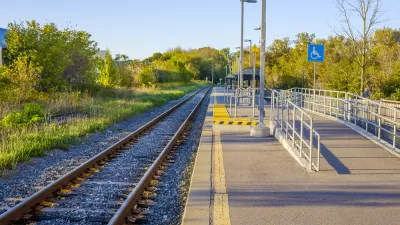While many cities have shown efforts to implement accessible design since the 1990 adoption of the American Disabilities Act, more must be done.

Steve Wright, writer, marketer and disability rights activist, provides a guest post for Smart Cities Dive to commemorate the 30th anniversary fo the sining of the Americans with Disabilities Act.
When the Americans with Disabilities Act (ADA) turns 30 this month, everyone whose work impacts the built environment — architects, engineers, urban designers, town planners and public officials — should be scrambling to observe the landmark federal civil rights legislation.
While the ADA is not a building code or some kind of zoning that can be ignored via variance, its biggest impact by far has been on the civic realm. Buildings, streets, crosswalks, trains, buses, parks, natural trails, city halls, schools, malls, libraries and much more have been made more accessible because of the ADA's adoption on July 26, 1990.
We still have a long way to go toward removing old barriers and approaching accessible design in a creative way, but we certainly are ahead of the game compared to the way life was before the ADA.
FULL STORY: The ADA is turning 30, but the built environment is still far from inclusive

Planetizen Federal Action Tracker
A weekly monitor of how Trump’s orders and actions are impacting planners and planning in America.

Vehicle-related Deaths Drop 29% in Richmond, VA
The seventh year of the city's Vision Zero strategy also cut the number of people killed in alcohol-related crashes by half.

As Trump Phases Out FEMA, Is It Time to Flee the Floodplains?
With less federal funding available for disaster relief efforts, the need to relocate at-risk communities is more urgent than ever.

Berkeley Approves ‘Middle Housing’ Ordinance
The city that invented single-family zoning is finally reckoning with its history of exclusion.

SEPTA Budget Slashes Service by 45 Percent
The Philadelphia-area transit agency is legally tasked with maintaining a balanced budget. Officials hope the state will come to the rescue with additional funding.

Connecticut Governor Vetoes Housing Bill
Gov. Lamont reversed his view on a controversial affordable housing bill that would have required municipalities to zone for set amounts of affordable housing to receive state funding.
Urban Design for Planners 1: Software Tools
This six-course series explores essential urban design concepts using open source software and equips planners with the tools they need to participate fully in the urban design process.
Planning for Universal Design
Learn the tools for implementing Universal Design in planning regulations.
Heyer Gruel & Associates PA
JM Goldson LLC
Custer County Colorado
City of Camden Redevelopment Agency
City of Astoria
Transportation Research & Education Center (TREC) at Portland State University
Camden Redevelopment Agency
City of Claremont
Municipality of Princeton (NJ)





























